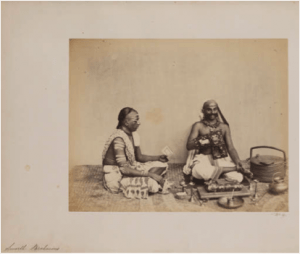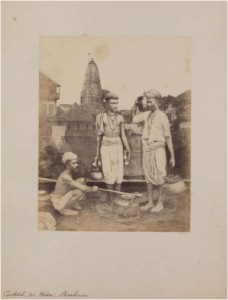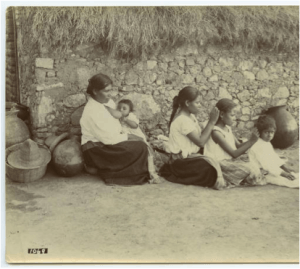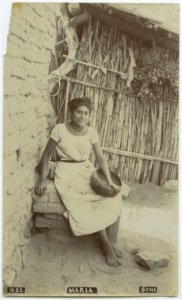Austin Eckhout
Edges of Empire
Ball-Phillips
April 30, 2015
The Justification of a Nation
As we look into the history books regarding the colonization of various native peoples, we see that there is no shortage of photographs and paintings regarding those that were colonized by European empires. Photographs, although presumed to always show the truth of a situation and perceived as more factual than a painting, can still be manipulated so that a biased opinion may be displayed for the viewer. In today’s era of technological advances and photoshopped beauty queens, we are much more aware of the fact that we cannot simply believe what we see. However, the Conquistadors and British Colonizers, of Mexico and India respectively, did not have access to anything this far advanced in terms of photography. Instead, photographs were manipulated prior to their capture. Through examination and analysis of these subtle manipulations, we are able to see the goals these colonizers had in terms of propaganda via photography. Through their images, photographers for both the English and Spanish empires were able to display the native peoples of their colonies as being less developed than Europeans. They portrayed these colonized people as being primitive by comparison in order to justify the colonization of these natives.
As you can imagine, many in Europe saw the colonization of natives in India as a controversial action. There are numerous reasons for one to view the complete takeover of a country and its people as being something to stand opposed to. A large part of what the British did in India was not simply the taking of land, but the complete reformation of the Indian lifestyle. During their colonization of India, the British forced their newly colonized people to convert to Christianity, as well as change and do away with many of their cultural practices. As with any major power, the British used various forms of propaganda to ensure that British citizens sided with their government. One of the strongest platforms on which the British government justified their colonization of India was photography. Photographs were used to display the Indian people in a number of ways. One of such idea was that of the Indian native being less developed, or civilized as a European. In the image below, we see two Indian men seated in traditional dress.
At first glance, this photograph seems to simply show two native men of India, seated and perhaps having conversation. However, it is through further examination that we uncover the suggestions of the photographer about these men.
Almost instantaneously, we see the attire of these men that any European at the time would view as peculiar. This trait alone does not label the men as being primitive or uncivilized. Upon a second look, we see that the man on the left has his skin painted. The face and body paint strongly resembles what would be seen as tribal markings. The man’s body paint, creating an idea of him being in a tribe, help to enforce that idea that the British government desired to portray to their citizens about Indian people. To add to the tribal portrayal of these two men, we have them seated cross-legged on the floor, unlike Europeans who sat in chairs. Though a small part of the photo, the idea of sitting on the floor would not be common in Europe and would be believed primitive.
In this image we see another display of Indian men in a way that depicts them as being less developed than the people of Europe. Similarly to the first photograph shown, these men are in traditional Indian attire. The two men on the left both have their torsos exposed, a practice that was seen as socially unacceptable in Europe and would cause viewers to think these men as being uncivilized in that their exposed upper bodies would not be tolerated in Europe. The three men appear to be collecting water, a practice that was no longer common in Europe, as technological advancements had made it unnecessary. This fact instills the idea that the people of India were far less advanced as a society, and therefore justified colonization through the belief that British involvement in the development of India would be beneficial to the native people, bringing them modern practices that would make their lives more acceptable by European standards. In the background of this image, we also see the living conditions of Indians. While, to us, these houses would seem fairly nice compared to what we know now to be the condition of modern India, these homes would be very simplistic compared to the homes in Europe. Their simplistic robes, coupled with their lack of modern conveniences and underdeveloped homes, further strengthen the idea that British colonization of India would be beneficial to the natives. The British government uses this idea to push its citizens towards the thought that not only are they justified in colonizing India, but that they also have a moral obligation to help advance the Indian people towards a lifestyle that had the comforts and modern “necessities” of Europe.
We turn our attention now to the Spanish colonization of Mexico and its native people. Unlike with the British in India, the Spanish faced different challenges in their conquest of Mexico. Conquistadors were not as lucky as the British with their colonization as they came across natives that were more resistant to colonization than those of India. While it is true that the Indians opposed their British rulers, the natives of Mexico rebelled much more and, being constantly at war with each other, were far more practiced in armed battle. The Spanish did not only find them selves fighting against the natives of Mexico, but also against the opinions of those back in Spain. To counter this, the Spanish government made use of the same tactic applied by the British. Among a number of incentives given by the Spanish government to persuade the Spanish people into supporting and joining in on the colonization of Mexico, they also used photographic propaganda to remind those in Spain that their presence in Mexico was both justified and necessary. Just as the British had, the Spanish were sure to depict the natives of Mexico as being primitive and uncivilized, as well as showing them to be heathens, having practices that were believed to be sinful in Christianity.
In the image pictured, we see a mother breast-feeding her child while two girls and a boy are seated in a line checking each other’s hair. Of course the first part of the photo that we see as being unordinary is the mother openly breast-feeding her child, but for now we will address the other aspects of the image. The setting of the photo, to a Spaniard, would be seen as below their standards of living. The ground that they are seated on is nothing but dirt and the wall of the house next to them is roofed by little more than grass. At the time, a home with grass for a roof would be viewed as underdeveloped with the advanced homes in Europe. A European also would see the collection of baskets and vases around them as odd. To keep your belongings outside and uncovered is another practice that would be primitive in Europe and therefore shows these natives to be primitive as well. Addressing the woman breast-feeding her child in the street, this is an act that would be seen as highly unacceptable by Europeans. Just as in our modern times, public nudity was not seen as something that should be allowed in Europe. For a woman to expose herself outside of her home was unheard of for modern Spaniards. All of the aspects of the photo support the idea of the native Mexicans being beneath their European rulers. The simple and underdeveloped condition of the home and uncivilized actions of the natives help to grow, in the minds of those still in Europe, the idea that Spanish rule in Mexico would result in a more developed and advanced society that would be seen as acceptable to the Spanish, who would grow to believe that it is their duty to help the natives of this colony to become more civilized.
In this photograph we have another example of a native of Mexico being displayed as less developed than the people of Europe. Starting with the setting of the image, we see that once again, the ground is only dirt and sand. In the background, there is a wall made only of branches and small trees. The combination of the wall and the dirt on which the subject is standing suggest a Mexico that is in disrepair and requires outside help.
The woman that is the subject of the photograph is not entirely unusual from a European standpoint. However, her lack of shoes while outside in the dirt can be seen as a representation of her not being a woman that has much. For Europeans, shoes were commonplace and, more likely, expected to be worn, especially when outside. She is seated on what appears to be a makeshift seat protruding from a wall of stone. This seat of hers is neither well made, nor does it resemble what a European would consider a seat. The wall and the seat jutting out from it appear to be falling apart almost and suggest a lack of engineering development in the society of Mexico. These living conditions would not be befitting of a European and, since the Spanish had so much to give in terms of advances in civilization, they were required to assist the natives of this colony in their development towards a more “European” society. This so-called “white man’s burden” served as a strong foundation for the Spanish conquistadors to justify their settling of Mexico.
Though their colonies were on opposite sides of the world, both the British and Spanish Empires faced similar difficulties in their colonial efforts. These problems were not only found in the natives that they were colonizing, but also rose up in the motherlands of these two empires. The moral disagreements held by Europeans towards colonization of the Indian and Mexican were handled the same by both colonial powers. To counter these beliefs of colonization being wrong, the Spanish Conquistadors and British colonizers both used photography as a form of propaganda. Through this platform, these two nations were able to justify their take over of India and Mexico by creating the idea that they were obligated to help develop the natives into civilized cultures.
Bibliography
Guha, Ranajit. Dominance Without Hegemony: History and Power in Colonial India. United States of America, Harvard College. 1997. Print.
Trivedi, Harish. India, England, France: A (Post-) Colonial Translation Triangle. University of Montreal. 1997. Print.
Pren, Hanns J. Spanish Colonization and Indian Property in Central Mexico, 1521-1620. Annals of the Association of American Geographers. 1992. Web.
Wood, Stephanie. Transcending Conquest: Nahua Views of Spanish Colonial Mexico. University of Oklahoma. 2003. Print.
Jackson, Robert H.; Castillo, Edward. Indians, Franciscans, and Spanish Colonization: The Impact of the Mission System on California Indians. University of New Mexico. 1995. Print.
Photographs
http://digitalcollections.smu.edu/cdm/singleitem/collection/eaa/id/711/rec/5
http://digitalcollections.smu.edu/cdm/singleitem/collection/eaa/id/710/rec/4
http://digitalcollections.smu.edu/cdm/singleitem/collection/mex/id/667/rec/5
http://digitalcollections.smu.edu/cdm/singleitem/collection/mex/id/671/rec/9




